Japanese Knotweed Foliar Spray Treatment
Following one of our in-depth surveys, we will select the best management plan dependant on the extent of the infestation. To manage the spread of the weed on your land, our expert team will often employ a range of methods. One of these methods is Foliar Spray Treatment.
Japanese Knotweed Herbicide Treatments
Method One: Foliar Spray
Timescale: 3-5 Growing Seasons
The plants are treated with a herbicide that has been approved by the Environment Agency. Knotweed is sprayed twice or three times in the first year, depending on the size of the infestation, and once in subsequent years, depending on the size of the infestation.
Dry weather is required for foliar treatment, and the soil must remain undisturbed in subsequent years. When the infestation is close to a watercourse, it is not permitted, and it is not the ideal option to utilise when the Knotweed is growing among other plants and flora that you want to maintain. The approach works best in the late summer when the weed is blossoming and has the most impact.
Using a knapsack sprayer, herbicides are applied to the top and underside of the plant leaves surface. This happens twice a year; once during the early part of the growing season (April – June) and then again during late summer/autumn (July – September).
How it works:
- Herbicides are applied to the top and underside of the leaf, this is absorbed and carried into the plant.
- The herbicide within the plant takes effect, and over a period of time kills the plant at its base. Time varies depending on different factors, taking effect from as little as 4 days, up to a few months. Repeat applications of herbicide cause the plant to become stunted and reduce its capacity to photosynthesise and therefore regenerate. You can expect over the course of 3 years the plant will completely die back.

Looking for a professional Japanese Knotweed Treatment Plan?
Our specialist team will visit your site to recommend the most appropriate management plan.

Method 1: Foliar Spray

Method 2: Stem Injection

Method 3: Cell Burial / Root Barrier



